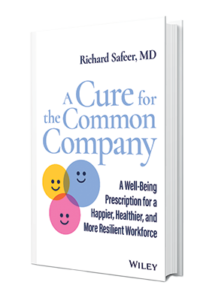$500 billion.
That’s the cost of poor health and neglected well-being of American employees. That’s more than the combined revenue of Apple and Microsoft in 2020. An unwell workforce contributes to medical and pharmacy claims, lost productivity, workers’ compensation, absenteeism, paid disability, and more. $500 billion.
In some of the biggest organizations, these healthcare costs are the largest items on their P & L accounts. Starbucks spends more on healthcare than on their coffee beans.
Even before Covid-19 entered our lives, chronic conditions, and a lack of systemic focus on employee well-being had already created a significant problem.
As Jeffrey Pfeffer of Stanford points out in Dying for a Paycheck, 61 percent of workers felt that their workplaces had made them sick. Stress and overwork might be leading to over 120,000 deaths a year. This is after spending $500 billion!
Don’t forget that Americans aren’t getting younger. An aging workforce means more chronic diseases and illnesses. Historically, the younger portion of a workforce has offset the higher cost of insuring their older colleagues. With a falling birthrate, and later retirement, that shell game is ending.
There’s a lack of self-care nationwide, perpetuated by a propensity for immediate gratification over consistent good choices. Companies are fueling the deterioration of our well-being by focusing on quarterly profits and personal ambitions over the greater workforce community. The lack of investment in our human resources will not go unaccounted for long. In fact, reconciliation has already started.
For those employers not already positioned with a healthy and well workplace culture, the upheaval created by Covid-19 was the final straw to spawn the Great Resignation. Unless a culture of health and well-being becomes a strategic objective, organizations – and the economy at large – will be facing a full-blown crisis. If companies and organizations want to be successful, which means having a viable and reliable workforce, the time to act is now.
This isn’t to suggest that companies haven’t taken note. A multi-trillion wellness industry has sprung up globally to address the problem. While business leaders and boards may be aware of the need to improve employee health and wellbeing, unfortunately they rely on skin-deep programs with little meaningful effects. The current solutions of health risk assessments and the wellbeing webinar of the day have demonstrably fallen short.
By focusing on the individual and putting the onus on employees to change, organizations are willfully ignoring their own role in the health and well-being of their workforce. We can not overlook the importance of the system that perpetuates unhealthy behaviors and thought patterns.
The current strategy for most organizations ignores the importance of the collective behaviors, attitudes and beliefs of the people who constitute the workforce. More simply, the current approach ignores culture.
Katy Milkman of Wharton reminds us there are many obstacles to change. Working in an organization with a culture of health and well-being makes it easier to overcome these obstacles. To create a culture of well-being, organizations need to move beyond transactional tactics and transform their approach.
What’s needed is a systematic overhaul, with long-term objectives that includes the active engagement of all stakeholders. When there is a culture of well-being present, we don’t need to ‘sign up’ to participate because we are already immersed. We receive well-being when the policies, environment, benefits, resources, and business practices are all aligned in a supportive direction.
A position like Chief Well-Being Officer sounds nice. It’s easy to implement, and importantly, assign responsibilities to an individual and their team. But cultural change requires the participation of everyone in the C-suite, managers, and team leaders. It also depends on how we treat each other – the person we’re next to right now, regardless of title.
Organizations will have to invest in and focus on six building blocks to create a culture of health and well-being. In the next six articles, you’ll learn more about these six culture-building blocks that not only support well-being and improve health, but will also increase job satisfaction, morale, and employee retention.


